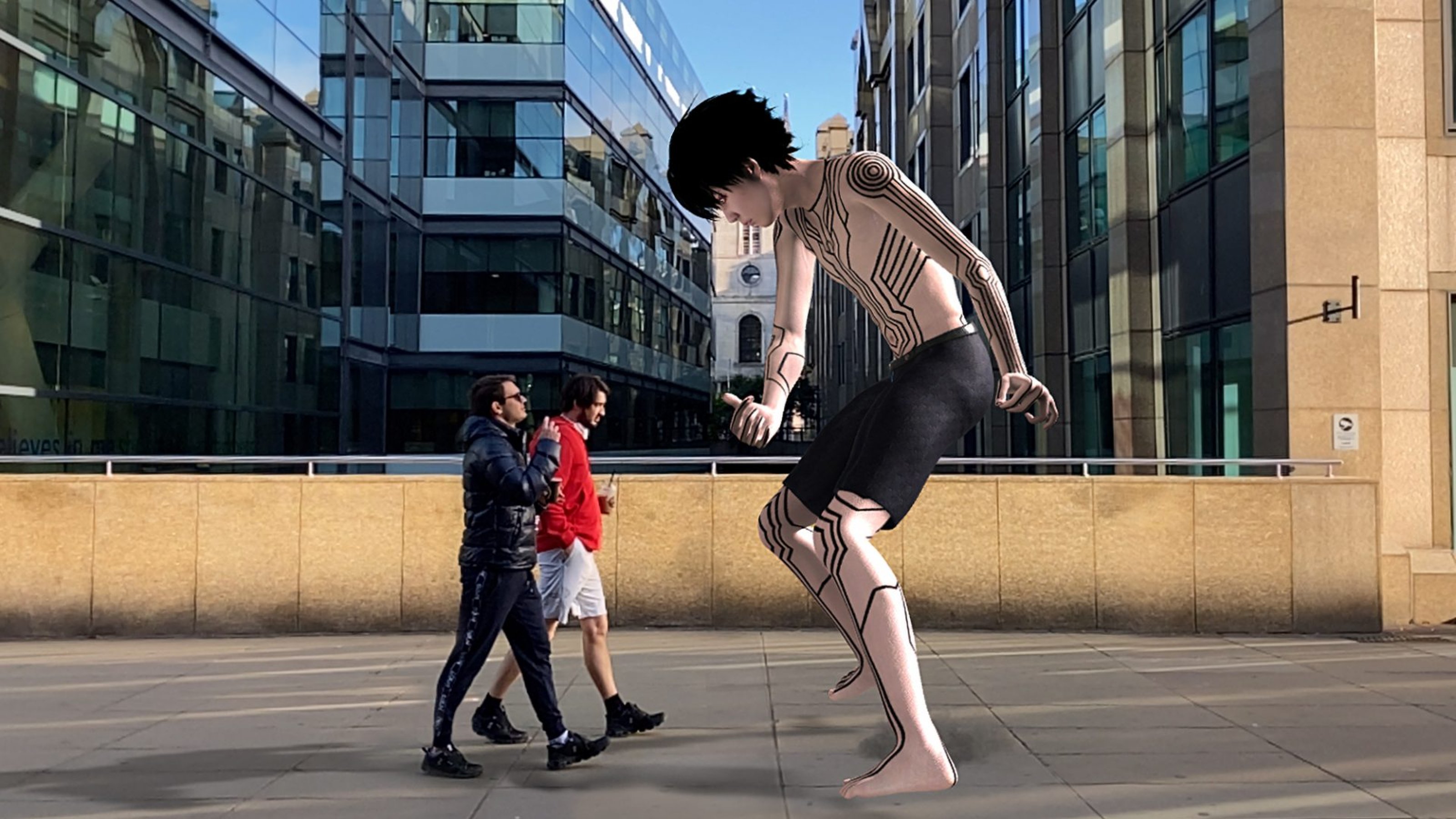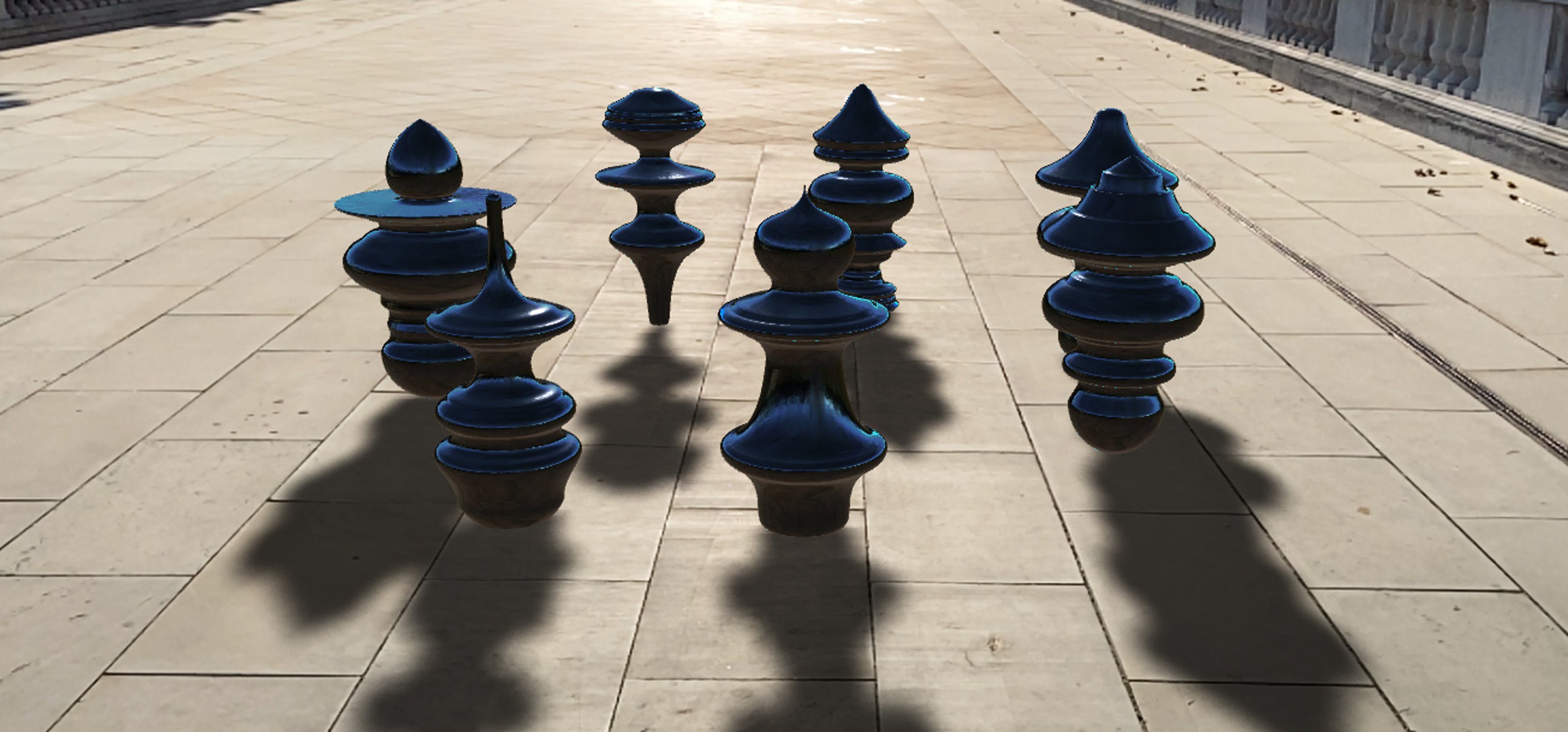
Artwork: Koo Jeong A / Density, 2019. Augmented Reality. Image credit to Acute Art.
What if, instead of going to an exhibition, you could just tap your phone and have the artworks appear right in front of you?
Like Olafur Eliasson’s AR work WUNDERKAMMER (2020) created by AcuteArt, with which you can place a little gray rain cloud right in your home wherever you are in the world. Or you could be walking in Regent’s Park in London and see a block of water floating in the air in front of you via your phone. That is Koo Jeong A’s AR artwork Density (2019).
In the past decades, Artists have been putting extended reality (XR) technologies such as Augmented Reality (AR) and Virtual Reality (VR) to use, but AR has seen a recent surge of interest from within the art world and various industries. Unlike Virtual Reality–which usually requires a full headset and sometimes induces physical discomfort–Augmented Reality is the art of overlaying virtual content on top of physical reality. Using AR apps on smartphones, iPads, and other devices; viewers look at the real world around them through their phone’s camera lens, while the app inserts additional images or 3D objects into the scene.
In his class l on Collecteurs Academy, Daniel Birnbaum, the director of Acute Art–the leading producer in the AR art scene–shares his vision on the present and the future of AR art. If you are interested in delving into the world of AR art before the course, here are 5 reasons why Augmented Reality art is worth your attention and 3 things to keep you grounded.
Ideally, an AR artwork can be placed anywhere in the world and be accessible to anyone at any time if that person has a smartphone and network connection. Hence, the pool of audience AR works can reach does not need to be limited by geographical or temporal boundaries, which is usually the case for any offline exhibition. Individuals at the polar opposite of the world can be looking at one AR work simultaneously. For example, Tomás Saraceno’s ongoing AR project Web of Life invites people around the world to locate spiders and spider webs around them and in turn, get access to a giant AR spider in their desired scene. If looking at the same art creates a community, then AR art is capable of creating expansive communities over the globe. In other cases, although many AR exhibitions are site-specific or are developed in a way available only in certain locations at a time, the mobility of AR exhibitions undoubtedly surpasses that of an art exhibition with physical works.
However, there is a boundary to the boundless potential of AR systems. While AR may allow the artist to set many more of the work’s boundaries than in traditional media, that freedom is still subject to the affordances of the software composing the work. And equally important, the access and impact of AR art are limited to the communities that can afford smart electronics.

Tomás Saraceno / Webs of Life, 2021. Augmented Reality. Image credit to Acute Art.

Nina Chanel Abney / Imaginary Friend, 2020. Augmented Reality. Image credit to Acute Art.
Much of AR art is focused on superimposing virtual objects and information onto real environments as a new form of public art. Indeed, AR art is not only boundless in terms of location and time, but it also offers the chance to operate under fewer regulations compared to physical public art. Because AR art only exists in the virtual, the control of it remains much of a gray area. Unlike physical art interventions, artists need not go through the convoluted process of seeking permission to put up an AR artwork in public spaces, at least not yet. As a result, we have seen some radical AR art for political activism. For instance, in Imaginary Friend (2020), American artist Nina Chanel Abney placed her character, a black figure in reminiscence of a religious figure, in Capitol Hill amidst the Black Lives Matter protests. Abney says: “As a visual artist, augmented reality not only offers me the opportunity to attune myself to these new configurations of space and public life; it also makes possible for the first time an interactive register of communication in my public artwork.”1 AR art not only creates an immersive and private experience of interacting with art in public but also offers the possibility to revolutionize what can be put up as public art.
The ability to draw one’s own curatorial borders and parameters is in itself freedom drawing from augmented reality’s strengths (Garbe, 2014). At the early stages of AR art, when its production was decentralized, many have put faith in AR art as a rigorous force disturbing the dominative powers within the art world. Because AR art was not yet admitted by the high art canon, people saw in it the opportunity to operate at least momentarily outside canonical influences and systematic problems within the art world. With people like Daniel Birnbaum making the move to take on roles in an innovative institution like Acute art, AR art was able to flourish and bring new ways of making, viewing, and interacting to the public. Many aspects of a conventional art exhibition were challenged: Does art have to be physical? Can going to an exhibition only be a public experience? Can I as an audience choose when or where to see the art instead of museums making that decision?

Lu Yang / Gigant DOKU, 2020. Augmented Reality. Image credit to Acute Art.
However, this freedom from this momentary lack of structure might not be there forever. With AR art being increasingly integrated as a regular category of art just like video art and with the wide adoption of AR art by art institutions just as another way of exhibiting work, AR art will eventually lose its fresh criticality and may lose some of the curatorial freedom it offers currently. On the other hand, as the technology of extending reality advances, and as virtuality become another recognized public space, soon we will see not only laws and regulations but also large corporations capitalizing on this virtual world. Then, putting up an AR work might become more gatekept or monetized.

Anish Kapoor / Into Yourself, Fall, 2018. Virtual Reality. Image credit to Acute Art.
The current success of augmented reality interventions is unquestionably due in part to the nature of the medium. Museums and galleries are always on the lookout for ‘cheap’ and efficient systems that deliver art engagement, numbers to satisfy the donors and the national institutions that support them, artworks that deliver visibility for the gallery and the museum, all of it without requiring large production budgets. Augmented reality artworks bypass these financial challenges— like video did in the 1970s and like digital screens and projectors have done in the 1990s until now— offering cheaper systems to display moving as well as static images. AR in this sense has a further advantage from the point of view of the gallery – the gallery no longer has a need to purchase hardware because audiences bring their own hardware: their mobile phones.

AcuteArt – Unreal City at Home, 2021

Alicja Kwade / AR-BEIT, 2020. Augmented Reality. Image credit: Acute Art
Cutting financial costs in this case also brings a tremendous reduction in ecological costs. Communication and collaboration in virtual environments have the power to significantly reduce emissions within all kinds of organizations. Air and land travel has shown itself to be a particularly devastating source of pollution. As for the art world, the effort and money that go into packaging and shipping are enormous. With AR art, the handling of artworks is completely eliminated. Indeed, the current ecological cost of running an AR exhibition is indeed trivial compared to that of a physical exhibition, taking into consideration installation, lighting, tickets, and administration. And with the money saved, art institutions may continue to invest in greener, more sustainable infrastructure.
BUT artworks living in virtuality are not frictionless. As Daniel Birnbaum points out in his course, these artworks, although clearly existing not in reality as physical matter, are still hosted by servers that are physical and energy-consuming. Additionally, the operation and maintenance of the AR system also leave a carbon footprint that should not be ignored, yet it is considerably smaller than traditional methods of organizing exhibitions.
The materiality of the medium and its technological revolutionary value plays a pivotal role in the success of AR artworks. It is ubiquitous, can be replicated everywhere in the world, can be installed with minimal hassle, and can exist independently from the audience, institutions, and governmental permissions. Capital and ecological costs for AR installations are minimal, in the order of a few hundred dollars, and they lend themselves to collaborations based on global networks. As for the future, some of these advantages will be gone, others will be accentuated. But AR art is deserving of your attention and criticality.
Article by Scarly Zhao for Collecteurs.
To learn about the making of AR work mentioned above and many others, to acquire a unique and sought-after view of the current AR art scene from a real insider, enroll now in Daniel Birnbaum: Curating the Virtual on Collecteurs Academy.